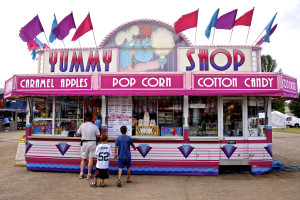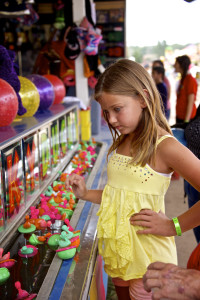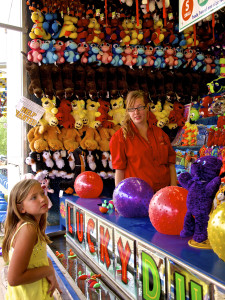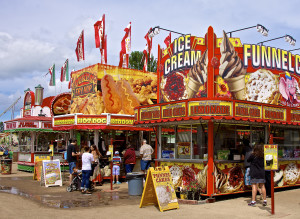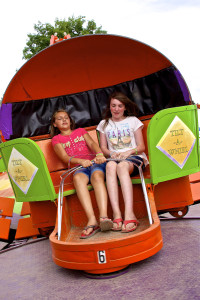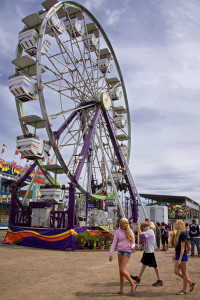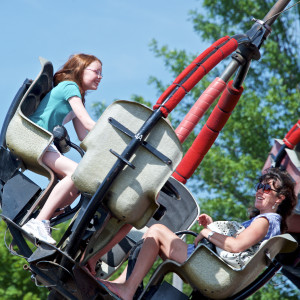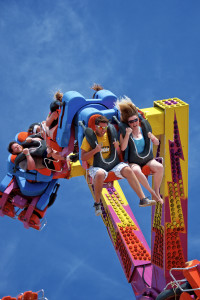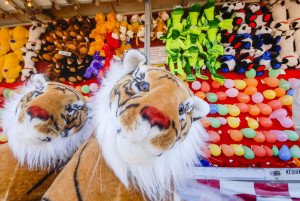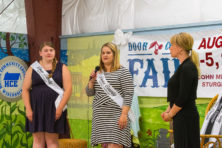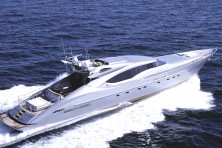Biggest, Finest, Fairest
- Share
- Tweet
- Pin
- Share
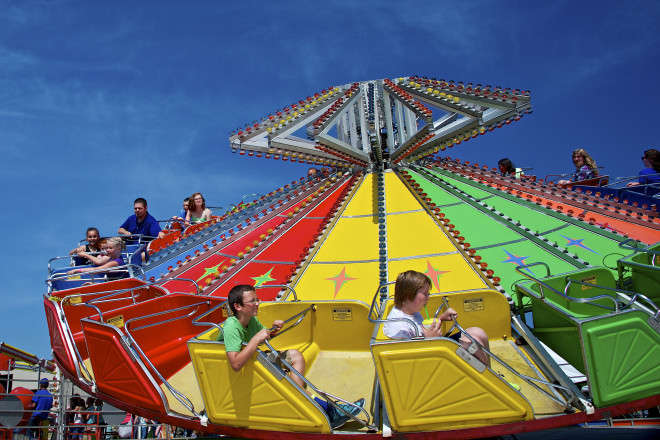
There was a time in the not-too-distant past when the end of summer was signaled in Door County by the arrival of the Door County Fair. The county fair of yesteryear was an event big enough to garner a sizable portion of front-page news, as indicated by the Door County Advocate headlines (opposite) announcing the war years “Victory Fair” of 1942. In its earliest days, Door and Kewaunee counties collaborated to put on one event featuring exhibits from both counties.
The advent of the automobile encouraged visitors traveling from Death’s Door and the Manitowoc County line to Sturgeon Bay. The entire effort prompted the Advocate to call the event the North Eastern Wisconsin State Fair.
Today, fair organizers don’t claim such a bold title and the event is exclusive to Door County, but John Miles County Park in Sturgeon Bay still features attractions and exhibits steeped in the history and tradition of the county.
“The main idea behind the fair is supposed to be the end of summer gathering for friends and neighbors to get together and show each other what they did throughout the year,” said County Fair Board President Thad Ash.
In a county where fairs and festivals are found every weekend through the summer, the Door County Fair looks to offer something that other events in the area do not.
“I think you get a lot more of the agriculture side of the county rather than the other festivals that each have their own thing,” said Ash. “I think this gets the people out of the agriculture setting but still in their home territory.”
Since the beginning, organizers have looked to offer something unique every year while holding onto the Door County culture. The Door County Advocate promotes “America’s Favorite Cowboy” Gene Autry making an appearance at the 1958 fair. In 1919, airplanes raced automobiles and cash prizes were offered to the horse races. In 1885, the Weekly Expositor Independent explained how organizers looked to “embrace everything raised or manufactured in Door County.”
This year’s events feature stock car racing, tractor pulls and a return of the demolition derby in addition to live music, animal exhibits and the 4-H Junior Fair.
While there is always something new at the fair, many of the events and attractions have their place in Door County Fair history. Tractors have replaced horses in pulling contests and rock bands fill the airwaves instead of vocal quartets. The demolition derby has been featured since 1950 when the Lucky Lott Hell Drivers put on the “World’s Wildest Show.” But the importance of the fair to agriculture and animal exhibits is still the foundation of the weekend.
The agricultural innovation and animal exhibits are what makes county fairs a hallmark of Midwestern states that pride themselves on farming. County fairs serve as a runway to state fairs, which got their start in the 19th century for the purpose of promoting state agriculture. In the early 1900s, as the country became more industrial, innovative technology was added to the fair lineup.
But before government-sponsored state and county fairs, there was a man with some sheep under a tree in Massachusetts.
Elkanah Watson is known as the “Father of U.S. agricultural fairs.” In 1807, this New England farmer set up a small exhibit of his well-groomed sheep under an elm tree in the middle of Pittsfield, Massachusetts. Watson claimed his sheep’s wool could beat the finest imported wool from England.
In his journals, now part of the New York State Library, Watson wrote, “Many farmers, and even women, were excited by curiosity to attend this first novel and humble expedition.”
In 1810, Watson expanded the event to include a Berkshire cattle show, featuring more than 500 animals. Watson promoted his first fair as a way to create competition and innovation in the
agriculture and livestock business. This concept remains true today.
Competitive livestock and produce exhibitions remain the focal point of the fair circuit, pushed along by the involvement of the area’s youth.
The 4-H Youth Development Program looks to empower youth to reach their full potential through cooperation with land-grant universities, county government and federal agencies. While the program features activities such as cake decorating, photography and political sciences, it is best known for agriculture and farm sciences.
“I think that’s the vital part of it,” said Ash. “Families and grandparents come to watch the youth and that’s what it’s all about. I’ve noticed in years past that the youth exhibiting and showing their work do an outstanding job of promoting it to their peers.”
Kids can compete in more than 20 categories, all of which are judged by experts in each individual field. One of the most competitive categories in Wisconsin is the Holstein cattle showing.
A Holstein cow is the most common of dairy breeds in the country. Its distinctive black and white color makes it easily recognizable. Professional judges look at the animals and score them. But what makes a good cow?
According to the College of Agricultural, Food and Environmental Sciences at the University of Minnesota, the better a cow is at producing milk, the better the cow.
These qualities include everything from foot angle and width of the ribs to bowed legs and depth of the udder. Cows are scored on five categories including frame, dairy character, body capacity, feet and legs, and udder. The highest scoring cow wins Grand Champion status.
Despite its importance in youth agriculture and education, the future of county fairs is cloudy.
Attendance and revenue from the fair has fluctuated the past 10 years, but since 2011, the Door County Fair has run a deficit. After the fair in 2014, Tom Ash, board member on the Door County Fair Board, requested the county provide an additional $15,000 to offset the losses from the event.
The Door County Fair is also the least-attended fair in Northeast Wisconsin, trailing the Kewaunee County Fair by an average of 7,000 attendees each year. Door County’s fair attracts the same number of visitors today as it did in 1928, despite a significantly greater number of tourists to the county in August.
“During the time period the fair is run, the county is full of people,” said former county supervisor Hugh Mulliken in a 2012 meeting of the Board of Supervisors. “I think a few minor changes could make the county fair the star fair of the state.”
These facts led the Door County Board of Supervisors to launch an Ad Hoc committee in 2012. The committee was charged with finding ways to make the fair more financially sustainable. In the report published in February 2014, the committee spoke with several groups involved with the fair and came up with their own recommendations for improvement.
The elimination of big-name bands from the grandstand was one of the first moves to balance the budget. Instead of acts such as Charlie Daniels and America, smaller, regional bands began headlining. This change came from an inability to sell enough tickets to make the high-profile act break even.
Rodeos, petting zoos and barn dances were just a few of the ideas proposed by committee members and the groups they spoke to. 4-H members also suggested healthy food options, trolleys from campgrounds, and paving the midway to reduce dust and dirt in the exhibits.
“Recommendations like having a more diverse and healthier menu at the food stands, sprucing up the display areas for the craft exhibits, and having a nicer looking midway were things that happened as early as 2013 even before the Ad Hoc committee finished,” said Rob Burke from the UW-Extension Office in Sturgeon Bay. Burke served as staff support for the 14-person committee.
The committee disbanded following the release of the report, but many of its members are still involved in the fair. This fact means continued improvements for the mid-summer weekend. At a time when county fairs across the country are in jeopardy, the Door County Fair is staying dynamic in order to fulfill the headlines it earned decades ago.
Tractor Pulling
In Jack London’s The Call of the Wild, a domesticated St. Bernard mix is thrown into the Alaskan wilderness and quickly proves to be an unmatched sled dog. His beloved owner wagers that the dog, Buck, can break a 1,000-pound sled loose from the ice and pull it 100 yards. Had London published the book today, he might have written about tractors.
Tractor pulling is known as the “world’s heaviest motorsport.” Yet, unlike other motorsports, the fastest vehicle is not always the winner. The goal is to travel the furthest distance along a 320-foot track.
Tractors pull a sled that is continually loaded with more weight as the tractor moves forward along the course. The distance pulled is usually measured to the thousandth of an inch and few machines can pull the sled the entire distance. Whoever pulls the sled the furthest is the winner.
“What has happened is that when the farm economy gets good like it has from 2010 to 2013, and these guys get money for their milk, they’ll take one of those farm tractors and take it to the specialty shops and get them souped-up,” said Harold Schnell from the Schnell Bros. Aggravator in Saint Nazianz.
The Schnell Aggravator will serve as the sled for the tractors at the Door County Fair. Schnell’s family has been travelling to fairs across the state since 1983, fighting back against the tractors that attempt to pull the Aggravator.
The Door County Fair discontinued the highest power tractor pulls for the 2015 fair following budget cuts and high costs of getting the highly modified tractors to Door County.
“Up in Door County we do not have what we call a heavy turbo class because there aren’t that many of those tractors up there,” said Schnell. The lack of dairy farming in Door County relative to other areas of northeast Wisconsin means a lack of the heavy turbo tractors.
Since these heavy turbo tractors are not street legal, competitors must load their tractor into a trailer and bring it to the venue, which can get expensive. Once at the site, these modified tractors incur other expenses.
“The problem is that it’s so costly to do – use them – because they don’t stay together,” said Schnell. “They were not designed for that kind of horsepower. They do what we call a lot of wrenching, they make one or two pulls and then they have to fix the tractor again.”
“When we were young and foolish we did that too,” joked Schnell. “We were lucky to get first place and get a trophy that the wife doesn’t want to dust off.”
Participants customize their engines to get the most power as fast as possible.
One of the challenges to pulling the sled lies in loading the front of the vehicle with as much weight as possible. This allows the front tires to dig out a track for the rear tires to follow. It also keeps the front of the vehicle on the ground, giving full traction on the dirt course as the weight of the sled increases.
As the sled is pulled further down the course, the weight on the sled shifts. Starting over the rear axle at the beginning of the pull, the weight moves forward on the sled, increasing the friction of the sled against the track. As the friction increases, the tractor struggles to continue pulling the weight.
When pulling sleds, drivers use two techniques. The popular method consists of a driver putting as much power into the tractor at the start of the pull, hoping to gain speed and momentum that will help in pulling the sled. The other method is a slow and steady approach. Tractors rely more on consistent power and traction to pull the sled the farthest.
Before high-powered tractors and mechanized sleds, horses and barn doors were the tools of competition. Back in the 1860s, when horses pulled farm equipment, farmers would bet on the strength of their horses. They ripped down a barn door and hooked it to a horse, laying flat on the ground. As the horse moved forward, people would jump on the barn door, increasing the weight the horse had to pull until it could not move forward any more.
History is not entirely lost at the Door County Fair, as the county has a big showing for the antique class of the tractor pull.
“There are a lot of tractors built prior to 1955 up in Door County and they are easy to get around because you can just take them on the road,” said Schnell.
Tractor pulling has its origins in the Midwest and remains a regional sport. No state west of Kansas is included in the National Tractor Pullers Association and Tomah, Wisconsin, is host to one of three Super National events every year.
Everyone must get their start, though, in local county events such as the Door County Fair.
Johnnie Miles is a Fair Nut
Anyone who has attended the Door County Fair has heard the name John Miles. In 2001, a 59-acre park in Sturgeon Bay was renamed John Miles County Park. The location on 14th Avenue has hosted the county fair since 1908.
But who is John Miles?
John Hobbes Miles joined the Door County Fair Board in 1928 and served as secretary for the Door County Fair from 1937 – 1971. His importance to the success of the fair through the depression years and for nearly half a century after earned him the title of Mr. Door County Fair.
Miles was born in Oskaloosa, Iowa, in 1893 and came to Sturgeon Bay in 1919 to work in the orchards after serving in World War I. He began attending the county fair before it was discontinued in 1923 for financial difficulties.
When the county appointed a new county agent, Ben Rusy, in 1927, one of the first agenda items was to reinstate the county fair. Rusy called on Miles to help revive the event.
“At that time, in 1928, as commander of the American Legion, the only veterans organization in Door County, and the fact that the Legion had a stand at the fairgrounds, seemed to be my qualifications for getting into the fair business,” wrote Miles in 1971.
During the depression era of the 1930s, community members volunteered to build the grandstand, livestock buildings and improve the roadways and midway on the fairgrounds. The group also enlisted the aid of the Works Progress Administration, the largest agency born out of Roosevelt’s New Deal. The agency paid for employees to work on public works projects around the country.
After providing the infrastructure, Miles coordinated events and promoted the event to everyone in the county.
“The Door County Fair through the years has developed and maintained an outstanding entertainment program and over the past several years… have improved the grandstand and entertainment programs to rate among the best in the state,” he writes.
“Over the past forty years I have visited more than half of the seventy-six county and district fairs in Wisconsin… and five other state fairs and some people refer to Johnnie Miles as a fair nut – but it is a great hobby and you meet a lot of wonderful people.”
Miles recognized the true nature of the fair: getting neighbors together to share their accomplishments from the year. This, combined with the goal of improving and advancing agriculture in Door County, persuaded John Miles to spend the better part of his life waiting for the gates at the grandstand to open again.
“I have remained in the fair business more or less ever since 1928 and it is very hard to entirely divorce myself from the fair. To my many friends, workers and associates I offer you my thanks and congratulations because it was all of you who made the Door County Fair the real successful fair it is and I am sure will continue to be.”
Demolition Derby
When fairgoers walk into the grandstand on Sunday afternoon, it may look like a junkyard art exhibit. Yet when these rusted cars start their engines, the crowd roars just as loudly as the engines.
The last car standing wins a demolition derby. Vehicles speed around an open pit and crash into each other, trying to cause enough damage so their opponent’s vehicle stops running.
The Door County Fair offers three divisions: full size, small car and truck. Small cars are the most popular given their abundance in junkyards, and vehicles tend to be from the 1960s and 70s. Larger, heavier frames that served as collision protection were popular in this era of the automobile.
Competitors often scrap for the frame of a vehicle before putting in the engine to make it run. Sometimes drivers will weld the doors shut, remove the bumpers, and relocate the battery and gas tank. All amenities such as plastic, lighting and glass are removed and the exterior is crudely painted with slogans and identification.
As a safety precaution, the driver’s side door is often painted a bright, contrasting color. Derby rules vary across different events, but it is typically illegal to crash into the driver’s side door.
Still, derby events can be dangerous and the attraction used to be reserved for professional drivers.
In the 1950s, the Door County Fair brought in “America’s Original Crash Test Dummies,” the Hell Drivers. This group of stunt drivers performed dangerous stunts all while destroying their cars.
The official origin of demolition derby is uncertain. In the early 1900s, following the over-production of Ford’s Model T, the excess vehicles were often driven into destruction for fun. In the 1940s, full contact automobile races were introduced. A used car dealer in Franklin, Wisconsin, promoted his own demolition derby in 1950 and Webster’s Dictionary officially recognized the term in 1953.
The future of the event is as uncertain as its origins. Many European countries have banned the practice due to the spilling of gas, oil and other fluids on open soil as well as the unfiltered exhaust from the vehicle.
The demolition derby has at least one more year of life at this year’s county fair.
Door County Fair
July 29 – August 2, 2015
Doorcountyfair.com
Grandstand Events
Wednesday, July 29: Stock Car Racing, 6:30 pm
Thursday, July 30: Lena Mini and Modified Tractor Pulls, 6:30 pm
Friday, July 31: Farm Tractor Pull with the Schnell Aggravator, 6:30 pm
Saturday, August 1: AMA Flat Track Motorcycle Racing, 7:00 pm
Sunday, August 2: Demolition Derby, 1:30 pm
Live Music
Wednesday, July 29: Vic Ferrari, 7:30 – 11:00 pm
Thursday, July 30: Johnny Wad Band, 7:30 – 11:30 pm
Friday, July 31: Boogie & the Yo-Yo’z, 7:30 – 11:00 pm
Saturday, August 1: Hurry Up Wait, 7:30 – 8:30 pm, Separate Ways, 9:00 – 11:30 pm
Sunday, August 2: Let Me Be Frank Productions, 1:00 – 4:00 pm

